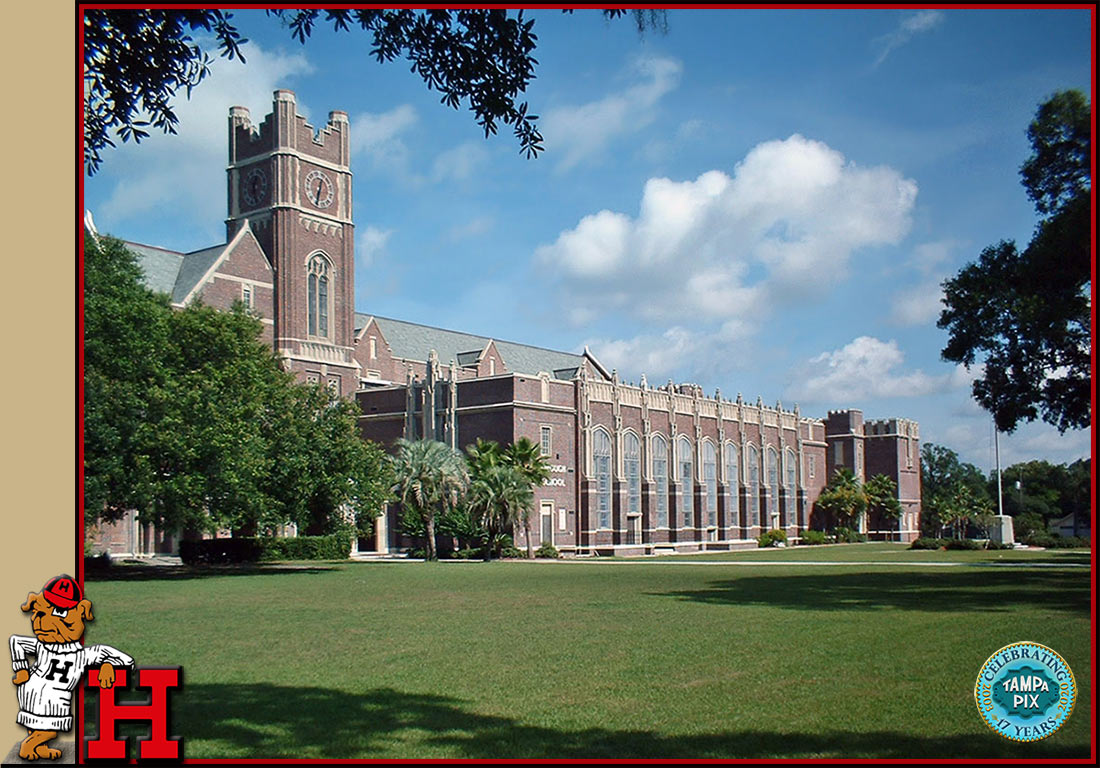W. P.
HAISLEY FAMILY TREE
According to the
combined research of a
few contributors at
FAMILYSEARCH.ORG,
William Penn Haisley was
the fourth of at least
six children of
Alexander Brown Haisley
and his wife Ann
Phillips. The
accuracy of this chart
has not been verified,
but there seems to be
enough source citations
presenting factual
evidence to corroborate William's
ancestry.

|
THE BUSY
LIFE OF
WILLIAM PENN
HAISLEY |
 Some of
the
information
which
follows
comes
from
three of
William's
obituaries
and a
one-paragraph
mini-biography: Some of
the
information
which
follows
comes
from
three of
William's
obituaries
and a
one-paragraph
mini-biography:
-
Ocala
Banner
obit
-
July
13,
1906
-
Tampa
Tribune
obit
-
July
15,
1906
which
was
a
reprint
from
one
that
ran
in
the
Ocala
Evening
Star.
-
Ocala
Banner
obit,
July
20,
1906
-
M'Kendree
College
Centennial
Catalog
mini-bio.
-
1928
They all
differ
somewhat
with
events
mentioned
that
another
may
omit.
Only one
mentions
his time
in Tampa
and the
same one
tells
why he
came to
Florida.
One
mentions
a degree
that the
other
three do
not.
Some of
the
events
appear
to be
out of
order
when
compared
to
actual
verifiable
evidence.
The
Ocala
Banner
politicizes
his
death
taking
opportunity
to
glorify
the
Democrat
rule in
Florida.
The
M'Kendree
bio in
their
1928
catalog
seems to
have
come
from No.
3, the
July 20
obit in
the
Banner.
Information
in
obituaries
is
usually
provided
by
friends
or close
family
members,
which in
W.P.'s
case
would
have
been
from his
wife,
Julia
and
probably
close
friends
in
Florida.
The
accounts
of his
life
before
Florida
may not
be
entirely
accurate
or in
chronological
order.
The
actual
obituaries
are
presented
near the
end of
this
page.
In the
account
of his
life
which
follows,
events
have
been
combined
in a
timeline
when
they fit
together
without
conflicting.
Inconsistencies
are
pointed
out and
explained.
|
|
BACKGROUND
William Penn
Haisley was
born during
the time his
parents were
moving from
North
Carolina to
Illinois,
and in the
political
conflicts
which
followed in
his
lifetime, he
strongly
espoused the
principles
which he
inherited
from his
ancestors.
William's
parents were
Quakers.
His father,
Alexander B.
Haisley,
born in
North
Carolina in
1802, was
the only son
known
of four
children of
John Haisley
and Mary
Shields.
Alexander
married Ann
Phillips in
Stokes Co.,
NC in 1822,
and their
first three
children
were born in
NC from 1824
to 1828.
Sometime
from 1828 to
1831, they
left NC for
Illinois,
stopping in
Indiana for
several
years where
they could
be
associated
with more of
the Society
of Friends
than they
had in their
home state.
William Penn
Haisley,
named for
Quaker
founder of
Pennsylvania, was
their fourth
child, born
in Wayne
County,
Indiana on
Dec. 21,
1831.
So it took,
at most,
around four
years for
them to get
to Indiana.
|
WILLIAM PENN
William Penn was a writer, early member of the Religious Society of Friends (Quakers), and founder of the English North American colony the Province of Pennsylvania. He was an early advocate of democracy and religious freedom, notable for his good relations and successful treaties with the Lenape Native Americans. Under his direction, the city of Philadelphia was planned and developed.William Penn by Henry Inman, 1832
Photo from the National Park Service |

|
| |
|
|

HAISLEYS IN
WAYNE CO.,
INDIANA
After
William's
birth, the
Haisley's
next two
children,
Rhoda
(b.1836) and
Mary (b.
1844), were
also born in
Indiana.
In 1845,
Alex's wife,
Ann
(Phillips)
Haisley,
died in
Indiana, so
it appears
that the Haisleys
spent around
fourteen
years there.
All of
William's
obits claim
they only
spent a few
years in
Indiana,
then moved
on to
Illinois.
But using the birth
years of the
children and
death year
of Ann
Haisley they
appear to
have spent
around 14 years
there after
William was
born.
Two of
William's
obits add
that the
area of
Jacksonville,
Ill. is
where
William
spent his
boyhood
years, but
the birth
places of
his younger
sisters
indicate
otherwise.

The Haisleys
spent about
14 years in
Wayne Co.,
Indiana,
before going
west to
Illinois.
INDIANA TO
ILLINOIS
1845


Alexander
Haisley
remarried in
Fayette
County in
1845, then
settled in
Bond County
by 1847-48.
William
would have
been around
16 to 17
years old.
Alexander
and his
children
completed
the last of
their
migration in
1845, when
they moved
to Illinois.
On Jun 9,
1845,
Alexander
married
Sarah E. (McMakin)
Custer in
Fayette
County.
Sarah E. was
the widow of
Samuel M.
Custer and
mother of
three young
children as
well. By
1850, the
suddenly-expanded
Haisley
family
settled in
Bond County,
Illinois,
where they
are found on
the 1850
Census.
By this
time, sons
John and
William had
moved out on
their own,
and their
sister Lodema had
married out.
|
|
|
|
 |
1850 Census,
Bond County,
Illinois
The
household of
Alexander B.
Haisley
On the 1850
Census,
Alexander
Haisley
is found in
Bond County,
IL, with his
second wife
Sarah E.,
three of his
children by
his first
wife Ann
(blue dots),
three of
Sarah's
children by
her first
husband (red
dots), and
two year old
Martha
Haisley, who
due to her
age of 2
should be
Alex and
Sarah's only
child
together to
this point
(purple
dot.)
It hasn't
been
researched
as to when
Sarah E.
was
widowed from
her first
husband,
Samuel M.
Custer
whom
she
had married
in 1835 in
Clark Co.,
Ohio.
They had
three
children:
Josephina
Custer,
Laura Custer,
and
Samuel M.
Custer Jr.
As seen on
the family tree
chart below,
Alexander
and Ann's
daughter
Sarah M.
Haisley
married
David Rench
shortly
after this
census. He
can be seen
in the
neighboring
Rench
families,
(blue
arrow.)
Ten years
later, Sarah
E's daughter
Laura Custer
would marry
John
Haisley,
Alexander &
Ann's son.
On the 1850
Census,
William
is found
several
pages away
in Bond
County as
seen below
after Sarah
E. McMakin
Custer's
tree.
|
|
Details of
Sarah E.
McMakin's
previous
marriage are
seen below.
|
 Was Samuel M. Custer related to Gen. George Armstrong Custer of "Custer's Last Stand" at Little Big Horn? 
Possibly, but if so, not closely. Gen. Custer was one of many sons of farmer and blacksmith Emanuel Henry Custer (1806–1892) and his second wife, Marie Ward Kirkpatrick (1807–1882). Gen Custer was born Dec. 5, 1839 in New Rumley, Ohio,. His father, Emanuel H. Custer (b. Dec. 10, 1806) would have been around the same age and generation as Sarah E. McMakin's first husband Samuel M. Custer Sr.
George A. Custer would have been ten years old when the 1850 Census was taken, so he would have been in the same generation of Samuel and Sarah E.'s children: Josephine, Laura and Samuel M. Custer Jr.
So were Emanuel and Samuel M. Custer Sr. brothers? Not likely, see this. Samuel M. Custer Sr. was also born in 1806. Emanuel's brothers were John Custer, Jr., George Washington Custer, James Cresap Custer, and Alexander S. Custer. But Samuel and Emanuel could have been cousins.
Gen. George A. Custer had brothers, Israel Kirkpatrick Custer, James Custer, Samuel Custer (b. 1838), Nevin Johnson Custer, Lt. Col. Thomas W. Custer, and half-brothers Brice W. Custer, Henry C. Custer, John A. Custer, and David Kirkpatrick.
George A. Custer and wife, Elizabeth "Libby" (Bacon) Custer.
Photo courtesy of
Frontier Partisans. |
|
W. P. HAISLEY IN
ILLINOIS
In 1850
William was out on his
own making a living as a
young carpenter, 20
years old, and living in
the same
dwelling with a
physician and his wife,
a young lady, and a
stage coach driver.
1850 Census, Pocahontas
town, Bond County,
Illinois
William P. "Hasley"

GREENVILLE, BOND CO. &
LEBANON, ST. CLAIR CO.
1853-1856


WILLIAM ENROLLS AT
M'KENDREE COLLEGE
In 1853, at about age
21, William enrolled at
M'Kendree College at
nearby Lebanon, ILL.
Lebanon is about 21
miles southwest of
Pocahontas where he was
on his 1850 Census.
M'Kendree College
published a yearly
catalog with information
about the school,
tuition costs, etc, as
well as lists of
students grouped
alphabetically by last
name in their Freshman,
Sophomore, Junior, and
Senior years.
Every three years, the
"Triennial catalogue"
(which would usually
also contain the Annual
Catalog) would contain
listings of graduates
grouped by year, for all
of the previous years
since 1840, along with
their degree and current
occupation.
|
William
first
appears in
the
Preparatory
program
enrolled in
the
classical
education
program of
the catalog
of 1853,
residing at
Greenville,
Ill. "Prepatory"
appears to
be what
would have
been called
later the
"Freshman"
class.
The school
also offered
a scientific
program. |
In 1854
William was
a sophomore.
He was still
living in
Greenville. |
|
 |
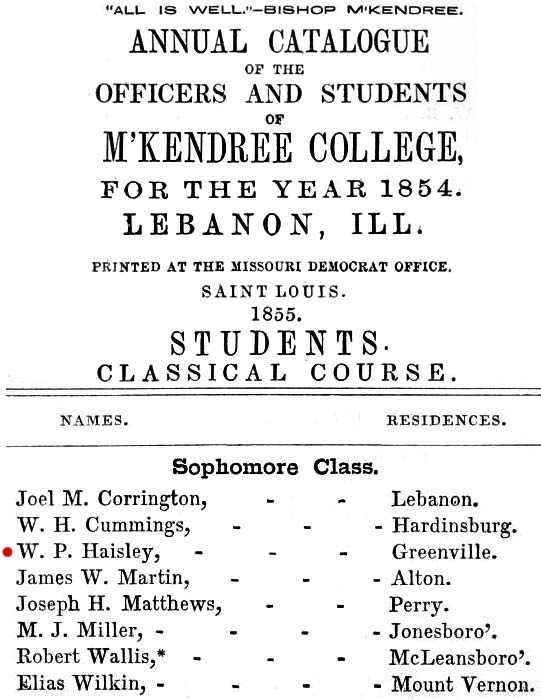 |
|
The soaring costs of a college education in 1854. |
|
Below is the course of study William would have been taking.in1853.
A year of the Collegiate program cost $24 in 1854. It would cost $677.50 in 2018. In reverse, what you buy in 2018 for $24 would have been like 80 cents in 1854. You can consider the cost of wood as if it was your electric bill, since there was no such convenience back then. |
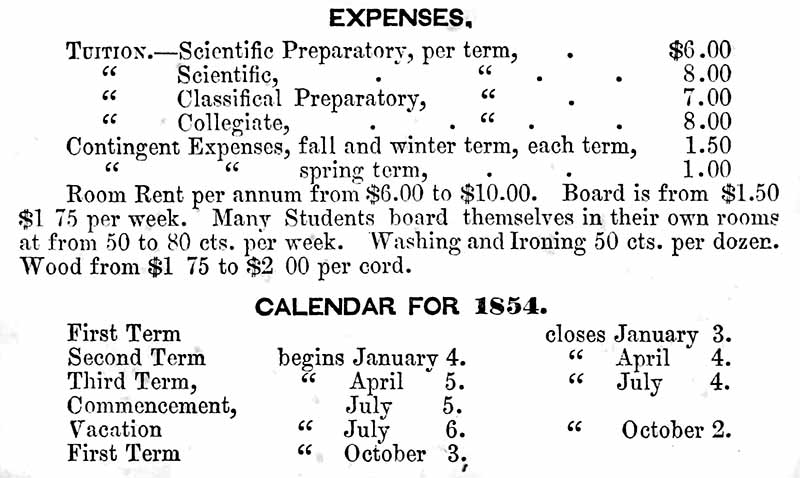
|
|
|
|
|
The engraving below is from the M'Kendree 1854 Catalog.
The reference to St. Louis, Mo. is the location of the artist and printer. |
The 1855 Catalog is missing, but in 1856 William was a Senior, so it is assumed that he was a Junior in 1855. |
|
|
 |
 |
|
In 1856 the
College
offered the
classical
preparatory
program, a
scientific
program,
Biblical
program, and
two foreign
languages:
German and
French.
They also
had a "Philosophian
Literary
Society,"
of which
William was
a member.
Each year
the college
grew in
faculty and
students.
In the 1857
catalog they
listed
Senior,
Junior,
Sophomore,
Freshman,
and GRAMMAR
SCHOOL
students.
WILLIAM
ABSENT FROM
M'KENDREE FOR
FOUR YEARS
|
 |
Despite the
fact that
William was
a senior in
1856, he wasn't one of
the only two
students
listed in
the 1857
catalog as
having
graduated in
1856.
What
happened?
Why would he
attend for
four years
then not be
listed as a
graduate in
next year's
catalog?
|
|
The next
catalog,
1858-59
was a
"Triennial
Catalogue"
so in
addition to
the current
student
listings by
class level
for that
year, it
listed the
college's
previous
graduates
starting
with two
graduates in
1840 and
ending with
1858's
graduates.
It also
included
their
occupation
at that time
in 1859.
William
wasn't
listed as an
1856
graduate.
In each
Triennial
Catalog,
three new
years of
graduates
were added.
In the
1859-60
Annual
Catalog, a
Law
Department
had been
added to the
curriculum.
William
wasn't
listed
anywhere
that year,
nor was he
listed in
the
1860-61
Annual
Catalog.
|
|
1861-1862 -
THE CIVIL
WAR BEGINS
It is at
this time
that all of
William's
obituaries
say he
graduated
from
M'Kendree
and Harvard,
one adds
Yale, and
two say he suffered
from a
debilitating
paralysis
for four
years:
-
At
the
outbreak
of
the
Civil
War
he
had
just
graduated
from
Harvard
college,
but
unfortunately
was
stricken
with
paralysis
and
remained
completely
paralyzed
during
the
four
eventful
years
that
followed,
and
was
unable
to
move
hand
or
foot.
(Ocala
Banner
obit
-
July
13,
1906)
-
At
the
outbreak
of
the
war,
he
graduated
at
Harvard
College,
but
was
taken
ill
shortly
after,
and
was
a
prostrated
victim
of
paralysis.
(Tampa
Tribune
obit
-
July
15,
1906,
reprint
from
Ocala
Evening
Star,
"The
Busy
Life
of
W.
P.
Haisley.")
-
He
graduated
in
the
Harvard
law
department
class
of
1861.
Subsequently,
he
took
the
degree
of
A.B.
at
Yale
University.
He
was
a
persistent
and
intelligent
traveler...
(Ocala
Banner
obit,
July
20,
1906)
No
mention
of
paralysis,
but
mention
of a
degree
no
other
source
has
mentioned--an A.B.
from
Yale.
-
He
graduated
from
M'Kendree in
1861, then
took a law
course at
Harvard
University
and received
the degree
of LL.B.
from that
institution. (1928
bio
in
the
M'Kendree
Centennial
Catalog.)
It continues
with later
events but
makes no
mention of a
paralysis
before or
after
Harvard.
William
was already
a senior at
M'Kendree in
1856, so he
must have
been close
to getting
an A.B.
degree.
What
happened
from 1856 to
1860 that
would
explain this
4-year
absence in
the student
listings?
ILLINOIS TO
MASSACHUSETTS
1856-1860

WHEN
DID WILLIAM
ARRIVE AT
HARVARD?
WHAT
HAPPENED
DURING 1856
TO 1860?
|
 The
1861-62
M'Kendree
catalog
(at right)
was another
Triennial
catalog.
For the
Alumni of
1861, (the
previous
year's
graduates--1860-61)
W. P.
Haisley
WAS listed
with an A.B.
(Bachelor of
Arts) and an LL.B.
(Bachelor of
Laws.)
The
M'Kendree
catalog
doesn't
indicate
that his
LL.B. came
from
Harvard. The
1861-62
M'Kendree
catalog
(at right)
was another
Triennial
catalog.
For the
Alumni of
1861, (the
previous
year's
graduates--1860-61)
W. P.
Haisley
WAS listed
with an A.B.
(Bachelor of
Arts) and an LL.B.
(Bachelor of
Laws.)
The
M'Kendree
catalog
doesn't
indicate
that his
LL.B. came
from
Harvard.
The catalogs
of officers
and
graduates of
Harvard
Univ. show
William
graduating
in 1861 with
a Bachelor
of Laws
degree,
at Internet
Archive

COMMENCEMENT
CEREMONY AT
HARVARD,
1861
July 17,
1861.—The
Intelligencer
The
Commencement
Exercises at
Harvard
College for
the academic
year of 1861
took place
yesterday,
and the
weather was
such as to
favor a
successful
fulfillment
of all the
intentions
of the day.
The
attendance
was as usual
quite
large....The
Board of
Overseers
met at Gore
Hall, at
nine
o’clock, and
concurred
with the
Corporation
in
conferring
the usual
Academic
Degrees, A.
B. and A.
M., in
course and
out of
course, and
the degrees
of LL D. S.
B. and M. D.
The Exercise
at the
Church
At 10
o’clock His
Excellency
the
Governor,
together
with the
Faculty,
present and
past
officers of
the College,
and a number
of
distinguished
persons,
took their
seats upon
the
platform, in
the First
Church where
the
exercises of
the
graduating
class are
usually
held. Upon
the
platform,
besides
Governor
Andrew and
his Staff,
Quartermaster
Reed,
Surgeon
General
Dale, Gen.
Stone, were
Hon. Edward
Everett,
President
Scars, of
Brown
University,
the senior
Professor of
Tufts
College,
Hon. J. C.
Gray, Rev.
L. R. Paige,
D. D., Judge
Russell, Dr
N. B.
Shurtleff,
and others.
After a
voluntary by
the Brigade
Band, prayer
was offered
by Rev. Dr
Peabody, and
the delivery
of the
essays by
the
graduates
began. These
were warmly
applauded by
the
assembly.
With the
exception of
a few
omissions,
the
programme
was the same
as that
published by
us on
Tuesday. The
degrees were
then
conferred,
as follows
Degree of
A.B....Out
of course,
the degree
of A. B. was
conferred
upon the
following
named
individuals;—...The
degree of A.
M. was
conferred in
course upon—
Out of
course—
Doctors in
Medicine—
Bachelor in
Science.—
Bachelors of
Laws:
...Charles
Conyers
Goddard,
John Chapman
Gray, Ross
Gaffia,
William Penn
Haisley,
Henry Berry
Hammond.
Thomas
Albert
Henderson,
Abijah
Hollis,
Edward
William
Hooper,
Thomas
Humphreys,
Obadiah
Jackson...
William's
degree from
Yale was
honorary.

From the
Yale 1895
Catalog at
Internet
Archive

William Penn
Haisley of
Tampa,
listed in
1904 with
an honorary
Law Degree
awarded by
Yale
University
in 1861.
|
GROWTH OF M'KENDREE COLLEGE CURRICULUM
THE 1867-68 10TH TRIENNIAL & 34th ANNUAL CATALOG
By this time, M'Kendree College had established quite a curriculum: |
1868-69 THE
35 ANNUAL
CATALOG
In this year
the college
add an 11th
department,
"Normal
Instruction"
and allowed
females to
attend.
It was
designed for
those who
were
preparing
themselves
to teach in
the public
schools. |
 |
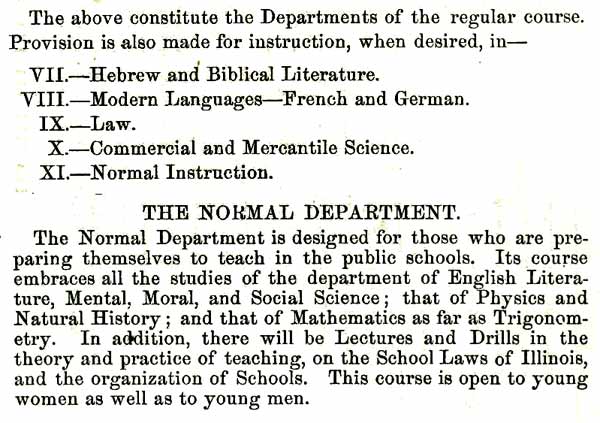 |
Textual
items at
Internet
Archive
containing "W.P.
Haisley."
When you
double-click
a hit and it
opens,
search the
text INSIDE
the item
without
quotes or
you will get
an error.
Advice on
searches:
Even if an
old
publication
is in
pristine
condition,
the text
search
feature may
still not
locate your
key word
because of
the ornate
fonts used
in the mid
to late
1800s.
As you can
see below.
In which
case, you'll
need to flip
page by
page.
Also search
for just
"Haisley"
without the
quotes.
|
|
LIFE
AFTER
HARVARD AS
DESCRIBED IN
WILLIAM'S
OBITS
-
As
soon
as
he
regained
possession
of
his
stricken
limbs
he
came
south
and
began
life
as a tutor
in
Mississippi.
Later
he
came
to
Florida
and
located
in
this
city,
where
he
opened
a
private
school,
which
he
managed
most
successfully.
He
also
taught
with
eminent
success
in
Tampa
and
afterwards
Texas
and
other
western
states.
(Ocala
Banner
obit
-
July
13,
1906)
-
On
his
recovery,
he
came
South
and
took
up
the
work
of a
tutor, teaching
in
Mississippi.
He
then
came
to
Florida
and
located
in
Ocala,
where
he
conducted
a
private
school
most
successfully.
Later
he
taught
in
Texas
and
Illinois.
(Tampa
Tribune
obit
-
July
15,
1906,
reprint
from
Ocala
Evening
Star,
"The
Busy
Life
of
W.
P.
Haisley.")
-
He
was
a
persistent
and
intelligent
traveler,
and
would
undergo
any
amount
of
hardship
and
toil
in
pursuit
of
the
knowledge
he
sought.
Ten
years
of
his
life
was
spent
traveling
solely
for
information.
In
1868
a
magazine
article
descriptive
of
Silver
Springs
induced
him
to
visit
Florida.
No
mention
of
private
school
teacher
before
next
event.
(Ocala
Banner
obit,
July
20,
1906)
-
He
was
an
intelligent
and
persistent
traveler,
and
spent
ten
years
of
his
life
in
traveling
for
the
purpose
of
securing
information.
In
1868
he
visited
Florida,
and
being
pleased
with
the
country,
eventually
settled
there.
No
mention
of
private
school
teacher
before
next
event.
(1928
bio
in
the
M'Kendree
Centennial
Catalog.)
Did William
experience
his
four-year
paralysis
from 1861 to
1865 in the
Northeast,
then head
straight to
Mississippi?
Did he first
go home to
Illinois, or
even
Indiana,
where he
remained
incapacitated
for 4 years?
Or had he
already
experienced
the
paralysis
before 1860,
then go to
Indiana or
Illinois and
teach up
there for 4
years, then
did he go
south to
Mississippi
at the end
of the war?
|
WHO ATTENDED
TO WILLIAM
DURING HIS
FOUR YEAR
PARALYSIS?
If William
was as
debilitated
as
described,
someone
would have
had to care
for him
almost 24/7,
but who?
If it
occurred
before he
went east to
Cambridge,
Mass in 1860., a
family
member in
Bond County
could have
done so.
If it
started
while he was
in
Massachusetts
in 1861, he
would have
likely had
to pay
someone
there to
care for
him there, or it
was along
hard trip
home to
Illinois for
him and his
caregiver.
ALEXANDER
HAISLEY AND
FAMILY MOVE
TO IOWA BY
1860

Sometime
from 1853 to
1860,
William's
father and
his family
had moved to
Cedar
County, Iowa
where he was
working as a
brick maker.
| 
|
Alexander and Sarah's 1860 census in Cedar County, Iowa, show they had another child, Vincent R. Haisley, age 7, born in Illinois. This indicates they were still in Illinois around 1852-53. |
| |
|
If William
convalesced
in
Illinois
after
Harvard
(during the
Civil War), he
may have
been
attended in
the home of
a sister.
There are a
few
newspaper
articles that suggest
William's
brother John
lived in
Wayne
County,
Indiana
|
|
|
THE LIFE
OF W. P. HAISLEY TO THIS
POINT, 1861
One fact is
certain--there
was a
four-year
gap during
his college
education. Obituaries
don't
usually
mention
something
unless it
happened;
it's often
the
chronology
that's
out of order.
On this
basis, and
the above
statements
in his
obituaries,
the
following
conclusions
are drawn:
-
His paralysis likely
occurred from 1856
to 1860 during the
gap from his senior
year at M'Kendree to
his attendance at
Harvard.
If this four-year
gap was for any
other reason, why then
was he not a
graduate at
M'Kendree in 1856?
-
It is doubtful that
he served in the
military during the
war. Being raised a Quaker,
he probably would not
have volunteered to
bear arms, and if he
was drafted, he
may have
been a conscientious
objector. At
graduation he would
have been almost 30
years old. The
question of when
William experienced
his four-year
paralysis
complicates matters.
-
There were a lot of
Haisleys in the area
of Wayne County,
Indiana. His
brother, John
Haisley, may have
been living there.
William may have
spent time
recovering there.
-
He traveled for
about ten years
total, including his
tutoring in
Mississippi, but not
all traveling took
place before coming
to Florida.
-
It is doubtful he
traveled in the
South during the
Civil War period of
1861 to 1864.
-
He came to Florida
in 1868 and settled
in Ocala, teaching a
private school for
two years.
-
He was teacher and
principal of Tampa's
Male & Female
Institute and was
hired for the
position by the
trustees in 1870, at
which time he had
been teaching
private school in
Ocala for two years.
(Since 1868.)
-
The loss of Tampa
newspapers from 1872
through 1876 leaves
uncertain as to when
he left his position
as Principal in
Tampa, leaving these
five years available
for more travel; to
teach in
"Texas
and other western
states."
His obit in the
Ocala Star says he
taught in Texas and
Illinois.
-
He came back to
Florida from his
western travels in
1876 and campaigned
in Florida for
George Drew's
governorship.
MASSACHUSETTS (TO
ILLINOIS?) TO
MISSISSIPPI 1861 - 1866
It would
have been a
scenic
riverboat
cruise down
the
Mississippi
from
Illinois to
the
Southland.
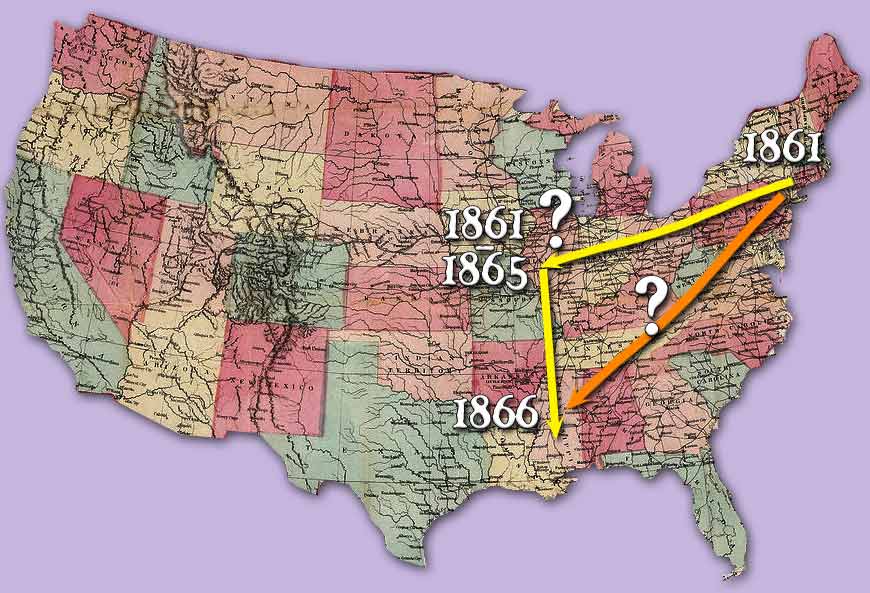
TUTOR IN
MISSISSIPPI THEN EAST TO
CHARLESTON, SC
Upon
obtaining his his
degrees from M'Kendree,
Harvard and Yale in
1861, William probably
went back to Illinois
for the period of the
Civil War, where he
either taught school or spent
four years recovering
from his paralysis.
Sometime around 1865 or
1866, William headed
south, making his way to
Mississippi where he
made a living as a tutor
for a year or two.
No records have been
found showing him in
Mississippi. Since
censuses were taken on
the end of each decade,
there would be no census
records of him there.
Mississippi would be
just over the Civil War,
and Reconstruction was
on the verge of
beginning.
Newspapers from around
the state for this
period show the great need for
tutors and teachers, and
William was likely aware
of this.
The Dec. 3, 1867 article
at below in the
Charleston, SC Daily
news shows that in late
1867 William left
Mississippi and went
east, arriving in
Charleston, SC where he
stayed at the Pavilion
Hotel.
 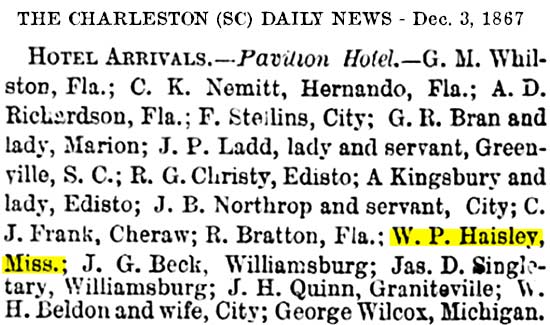
In 1868 a magazine
article descriptive of
Silver Springs induced
him to visit Florida.
He
located in Ocala, where
he conducted a private
school most
successfully.


No
mermaids back then.
Stern-Wheeler Arriving
at Silver Springs,
Florida, after an
Overnight Run up the St.
Johns, Oklawaha, &
Silver Rivers, 1886
Albumen silver print
from glass negative
courtesy of A. Hyatt
Mayor to
Metropolitan Museum of
Art Internet
Archive Python
library 0.5.1
Photographs, Albumen
silver prints, North and
Central America, United
States, 1886, Albumen
silver print from glass
negative, Metropolitan
Museum of Art
W. P. HAISLEY HIRED TO
TEACH IN TAMPA



According to
the
Oct. 12, 1870 article, William had
been teaching in
Ocala for two years.
However, he didn't have
an
"A.M."
degree--Master of Arts.
He had an A.B.--Bachelor
of Arts, and LL.B.--Bachelor of Law.
"He comes among us with
the best of
recommendations as a
teacher and a high-toned
gentleman."
Below: The start and end
of first quarter of
the "Tampa Male and
Female Seminary" Tampa
School


The ad
below was the same one
they ran the previous
year. The
tuition per quarter was subject to a deduction
proportional to the funding it received from the
county and state school boards, which included the
Peabody Fund. "The board is in posession of
abundant testimonials as to the character and
qualifications of Mr. Haisley."


The above ad ran all
year long in 1871, each
week, even past the Oct.
17 opening date, up to
the gap in Tampa
newspapers.
This
school had the most
complete curriculum,
especially for the
intermediate and higher
level courses.
By
Feb. 1871, this school
had 55 pupils.

FIVE-YEAR GAP IN NEWS
Now we lose five years
of sources in the loss
of the Fla. Peninsular
newspapers from 1872
through 1876.
FIRST NEWS OF 1877
The trustees have hired another
principal during the
five-year gap in
newspaper history.
N.
Fellows is the
principal in the
school's first ad in the
first Peninsular after
the five-year gap.
The History of
Hillsborough County
Schools says this:
Board minutes in
1876 appointed
Professor Fellows as
a teacher of School
# 1 and principal of
all other schools in
Tampa. Later in
1877, Board minutes
documented the
appointment of Dr.
Fellows as the first
principal of Tampa
School #1, also
known as Tampa High
School.
An 1892 article in the
Peninsular makes
reference to Haisley
teaching at the school
in 1872, so from the
time Haisley left Tampa
to the time Prof.
Fellows was appointed as
a teacher in 1876 leaves
about four years of
unknown leadership for
this school.
As
early as 1870, Mr.
Haisley made
investments of real
estate in Tampa and
predicted that it
would become the
most important city
in Florida, and
during the time of
the yellow fever
visitation to that
city and the other
calamities that
befell it, remained
unshaken in his
predictions
concerning it, and
it was a great
gratification to him
to have lived long
enough to see his
predictions
realized.
(Ocala
Banner
obit
-
July
13,
1906)
Mr. Haisley
ever had great faith
in Tampa; that in
time it would be the
leading city in the
state, and with that
belief he invested
his surplus money in
Tampa realty, and
not withstanding the
vicissitudes through
which it passed, it
has fully grown up
to his fond
expectations, and
the acres he
acquired twenty-five
years ago at a
pittance are now
worth a fortune.
He also became the
owner of a fine
orange grove on old
Tampa Bay, which has
given him good
returns during the
past years.
(Tampa
Tribune
obit
-
July
15,
1906,
reprint
from
Ocala
Evening
Star,
"The
Busy
Life
of
W.
P.
Haisley.")
TAMPA TO TEXAS TO NEVADA
TO CALIFORNIA 1872 -
1874

WILLIAM LEAVES TAMPA in
1872 FOR ABOUT FOUR MORE YEARS OF
TRAVEL
-
He
also
taught
with
eminent
success
in
Tampa
and
afterwards
Texas
and
other
western
states.
(Ocala
Banner
obit
-
July
13,
1906)
-
Later
he
taught
in
Texas...
(Tampa
Tribune
obit
-
July
15,
1906,
reprint
from
Ocala
Evening
Star,
"The
Busy
Life
of
W.
P.
Haisley.")
-
He
was
a
persistent
and
intelligent
traveler,
and
would
undergo
any
amount
of
hardship
and
toil
in
pursuit
of
the
knowledge
he
sought.
Ten
years
of
his
life
was
spent
traveling
solely
for
information.
(Ocala
Banner
obit,
July
20,
1906)
-
He
was
an
intelligent
and
persistent
traveler,
and
spent
ten
years
of
his
life
in
traveling
for
the
purpose
of
securing
information.
(1928
bio
in
the
M'Kendree
Centennial
Catalog.)-TRIBUNE---WP-Haisley-arr-from-Nevada.jpg)
No evidence have been
located for William in
Texas, but it does
appear he went as far
west as possible.
The article at right in
the Oakland, CA Tribune
shows he was due to
arrive there by train on
Oct. 14, 1874, and he
was from Nevada.
Maybe he stopped in Utah
to see the Great Salt
Lake.
FROM CALIFORNIA TO OREGON
- 1874-76

W. P.
Haisley turns up in
the
Sept. 1,
1876 report
of the State
Superintendent
of Schools
in Salem,
Oregon, in the
section
about
teacher
certification
and the
requirements
of State
Certificate
in the
orders of
Life
Diplomas,
State
Diplomas,
State
Certificates
of the First
and Second
Grade.
These
were
classifications
of the
certificate,
not school
student
grade levels.
In order to receive a
First Grade certificate,
the applicant had to
have testimonials of
good moral character,
have success in teaching
for at least six months,
and pass exams in
several subjects
answering at least 90%
correctly.
W.P.
Haisley is
named as
having a
First Grade
State
Certificate
in Oregon.
Is this our
W. P.
Haisley? Probably,
but no way to
know for
sure without
further
research.
However, a
search of
Oregon
newspapers
from 1871 to
1876 for
"teachers"
finds
hundreds of
articles
each year
for county schools
wanting
teachers for
hire,
especial for
the native
American
tribes
schools in
Oregon.
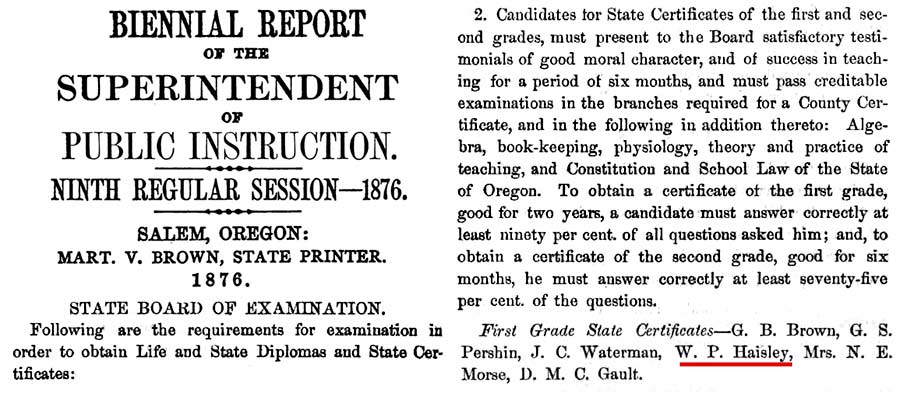
WILLIAM HEADS EAST,
1875-76--OREGON -- TO IOWA?
Williams father,
Alexander B. Haisley,
died in Jones Co., Iowa
on Sep. 23, 1875.
This article in the Jan.
18, 1877 L.A. Evening
Express lists names of
persons having mail
waiting for them to
claim at the post
office. It may have been an
effort to contact
William at his last
known location that his
father was ill. News of this may have
just reached William in
Oregon sometime in1876
after being
state-certified to teach
there, and so he
may have left Oregon
headed for Iowa.

No evidence of this has
been located; this is
speculation based only
on the timing of
Alexander's death and
the above article.
|
The 1870
Census of
Iowa shows
Alexander,
his wife
Sarah E.,
and their
son Vincent,
living in
the Rome
Township of
Jones
County.
Alex was a
stone and
brick mason. |
 |
|

Alex B.
Haisley
tombstone at
Olin
Cemetery in
Jones Co.,
Iowa.
Age 73 yrs,
2 mos, 11
days puts
his birth
day as 1802
July 12
Photo by
Sandy
Stewart at
Find-A-Grave.
|
WILLIAM
RETURNS TO
FLORIDA BY
NOV.
1876 AND
CAMPAIGNS
FOR GEORGE
F. DREW FOR
GOVERNOR
-
He
returned
to
Florida
and
took
a
prominent
part
in
the
campaign
of
1876,
making
a
thorough
tour
of
the
state
in
the
interest
of
the
democratic
ticket,
having
as
his
colleagues
such
distinguished
gentlemen
as...George
F.
Drew
and
others...In
recognition
of
his
valuable
services...Mr.
Haisley
was
appointed
by
Gov.
Drew
to
the
Office
of
superintendent
of
public
instruction
and
made
a
reputation
in
that
office
which
fully
met
the
promises
of
his
friends.
(Ocala
Banner
obit
-
July
13,
1906)
-
He
returned
to
Florida
shortly
before
the
political
campaign
of
1876...and
took
the
stump
(traveled
the
countryside
making
campaign
speeches)
with
such
distinguished
patriots
as...George
F.
Drew
and
others. It
was
in
this
campaign
that
Geo.
F.
Drew
was
elected
Governor
and
for
the
valuable
services
rendered
during
the
campaign
Mr.
Haisley
was
appointed
superintendent
of
public
instruction,
and
filled
the
office
with
efficiency
and
honor.
(Tampa
Tribune
obit
-
July
15,
1906,
reprint
from
Ocala
Evening
Star,
"The
Busy
Life
of
W.
P.
Haisley.")
-
He
was
so
pleased
with
the
country
that
he
determined
to
cast
his
lot
with
the
Floridians
and
make
his
home
there.
From
1877
to
1881
he
was
a
member
of
Gov.
Drew's
cabinet,
holding
the
position
of
state
superintendent
of
public
instruction.
(Ocala
Banner
obit,
July
20,
1906)
-
He
was
an
intelligent
and
persistent
traveler,
and
spent
ten
years
of
his
life
in
traveling
for
the
purpose
of
securing
information.
In
1877
he
was
elected
Superintendent
of
Public
Instruction
for
the
state
of
Florida.
(1928
bio
in
the
M'Kendree
Centennial
Catalog.)
The election
was held on
Nov. 7,
1876, along
with the
Presidential
Election. In
1876 Drew
won the
Democratic
nomination
for governor
and defeated
Republican
Marcellus
Stearns in a
controversial
election by
the
razor-thin
margin of
24,179 to
23,984. Drew's
election
ended
Reconstruction
in Florida. |
|
|
GEORGE
FRANKLIN
DREW -
FLORIDA'S
REDEMPTION
GOVERNOR
FROM:
George Drew
was stout,
grey haired
and around
fifty years
old when he
gave his
inaugural
speech on
Jan. 2,
1877.
He was a
political
unknown
before the
election of
1876 and was
called
"Millionaire
Drew" by his
neighbors.
Born on a
farm in New
Hampshire in
1827, he
only had a
grammar
school
education.
He came
south in
1847 and
opened a
machine shop
in Columbus,
Ga., and
also engaged
in lumbering
in that
state.
The start of
the Civil
War was a
dilemma for
Dew, his
wife was a
Georgia
belle and
his
livelihood
was in the
South, but
his
sympathies
were with
the North.
His Unionist
beliefs were
unfavorable
to this
Georgia
neighbors,
so after the
war he moved
to
Ellaville,
Florida,
where the
railroad
crossed the
Suwannee
River.
In 1865, he
built
Florida's
largest
sawmill at
Ellaville on
the Suwannee
River at the
east end of
Madison
County.
During
Reconstruction
in Florida,
Drew, who
was a former
Whig, held a
county
office under
the
Republicans.
His choice
as the
Democrat
candidate
for Governor
in 1876 was
largely due
to his
appeal to
the Whig
Unionist
elements and
the Negro
population.
No small
part in the
choice of
his
candidacy
was his
ability to
finance his
own
campaign.
The
Republicans
once again
selected
incumbent
Marcellus
Stearns.
William D.
Bloxam, the
Democrat
party's
leader
during
Reconstruction,
was
basically
broke.
He had
neglected
his Leon
County
plantation
to pursue
politics.
So Drew's
appointment
of Bloxam
for Sec. of
State was no
small favor.
Drew
appointed
members of
most all
factions of
the
Democratic
party, but
NOT the KKK-like
young
Democratic
clubs.
This action
had a
tendency to
confirm that
Drew would
actually
attempt
conciliation
between the
races.
Both houses
of Drew's
legislature
supported
him.
His Senate
majority was
14 to 9, his
House
majority was
32 to 18.
Drew had
additional
power,
ironically,
by the
provisions
of the
carpetbag
Florida
constitution
of 1868,
whereby
almost every
political
appointment
could be
made by
Florida's
governor.
At his
inauguration
speech, he
ignored the
hostility of
his
predecessor,
Republican
Reconstruction
Gov.
Marcellus
Stearns, and
the presence
of armed
white
Democrats.
He promised
the mixed
audience he
would follow
the middle
of the road,
and assured
the Negroes
present that
their
constitutional
rights would
be fully
sustained.
His
statement,
"We are a
law abiding
people,
resolved to
perpetuate
free
institutions,"
rebuffed the
extremists
on both
sides.
He
drastically
cut taxes
and
expenditures
during his
term of
office and
established
the convict
lease system
as an
economy
measure.
In sending
his program
to the
legislature
on Jan. 10,
he followed
the line for
conservative
Southern
Democrats'
economic
policy,
saying "that
government
will be the
most high
esteemed
that give
the greatest
protection
to
individual
and
industrial
enterprises
at the least
expense to
the
taxpayer...spend
nothing
unless
absolutely
necessary."
Faced with a
$90,000
deficit from
the
preceding
Republican
administration,
he advised
the sharp
cutting of
expenses
rather than
immediately
cutting
taxes.
His first
cut was to
eliminate
the state
penitentiary
at
Chattahoochee,
saving
$25,000 a
year, and
established
the convict
lease system
in its
place,
though the
system had
been used to
some extent
by the
Republicans.
The
penitentiary
building
became the
state insane
asylum and
the cost of
boarding its
patients in
out-of-state
institutions
was
eliminated.
On schools
Drew bluntly
told his
thrifty
partisans
that it was
"cheaper to
build
schoolhouses
and maintain
schools than
to build
poorhouses
and jails
and support
paupers and
criminals."
Courageously
leaving no
doubt where
he stood on
Negro
education he
told the
legislators
that it was
the state's
responsibility
to educate
the Negro so
that he
might vote
intelligently
and make a
good
citizen.
Minor
improvements
in the free
school
system
included the
encouragement
of rural
education
and the
standardization
of school
textbooks
(thanks to
the efforts
of W. P.
Haisley).
But his
enthusiasm
for public
schools was
limited to
the
elementary
level.
One of his
first acts
was the
abandonment
of the
Florida
Agricultural
College
which was
about to
open at Eau
Galle.
The chief
sponsor of
it was
William H.
Gleason, the
state's
lieutenant
governor for
a time
during the
first
Republican
administration
in
Reconstruction,
Harrison
Reed.
So Florida
continued in
the 1870s to
be without
an
institution
of higher
learning,
public or
private.
In a later
message,
Drew even
advocated
the
elimination
of public
high
schools.
In closing
his
inauguration
speech, Drew
called on
the state
legislature
to "bury the
passions of
the past
because all
within the
state were
one people,
with one
hope hope
and one
destiny." |
|

Haisley took
office on
Jan. 6, 1877
so news
articles
regarding
the
appointment
would have
appeared
soon after
the Jan. 6,
1877 Sunland
Tribune.
Unfortunately,
papers are
also missing
for the rest
of January
through
mid-March of
1877.
. |
|
FLORIDA PEABODY FUNDING CUT |
|
|
In the
fall of 1877, a Peabody Fund agent
contacted State Schools Superintendent
W. P. Haisley to notify him of a
pending cut in funding.

.
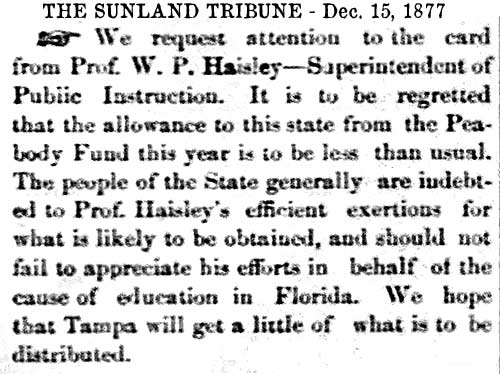
|
Haisley
had actually asked for more funding for
the upcoming year, but in view of Mr.
Sears's letter, Haisley responded asking
that Florida not be cut off entirely,
and be funded with enough so that
schools here which have not yet been
benefited by the fund could still be
funded. He asked for about
one-half of the amount of funding from
last year--$3,000.
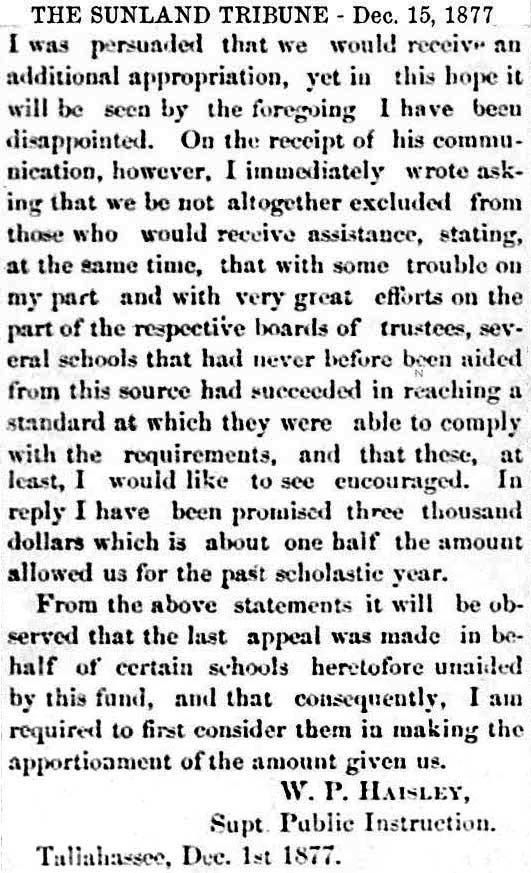
|
|
WILLIAM PENN
HAISLEY
MARRIES
JULIA
SIMMONS
PRIEST
-
Mr.
Haisley
was
married
in
Ocala*
to
Mrs.
Julia
Simmons
Priest...and
afterwards
made
this
his
home...
(Ocala
Banner
obit
-
July
13,
1906)
*They
married
in
Philadelphia.
-
Shortly
after
this...Mr.
Haisley
was
married
to
Mrs.
Iola**
Simmons
Priest,
one
of
the
handsomest,
most
accomplished
and
lovely
women
in
the
state,
and
they
have
made
their
home
in
Ocala
ever
since,
at
the
corner
of Oklawaha
and
Osceola
Streets.
(Tampa
Tribune
obit
-
July
15,
1906,
reprint
from
Ocala
Evening
Star,
"The
Busy
Life
of
W.
P.
Haisley.")
-
In
1878
he
married
a
daughter
of
the
late
Mrs.
Mary
McIlvaine
Simmons
of
Lewes,
(Delaware.)
(Ocala
Banner
obit,
July
20,
1906)
-
In
1878
he
was
married
to
Miss
Julia
Simmons
of
Lewes,
Delaware,
who,
as
his
widow,
still
survives.**(1928
bio
in
the
M'Kendree
Centennial
Catalog.)
**Perhaps the original
handwritten draft of
this obit was sloppy and
"Julia" looked like
"Iola."

On May 1, 1878 William
married Mrs. Julia
(Simmons) Priest in
Philadelphia.
William would have been
46.
Julia
would have been around
38 to 40 years old.
Julia was a widow
and had been living in
Florida since 1861, "for
many years a resident of
our State and thoroughly
identified with its
every interest."
She
was
born in
Philadelphia
in 1837 to
Edmond
Simmons and
Mary McIlvaine.
According to
her
obituary,
Julia moved
to Ocala in
the early
part of
1861.
JULIA'S SIMMONS
FAMILY
Julia's father, Edmund
(or Edwin)
Simmons, died in
Philadelphia before
1850.
By 1850, Julia's mother,
Mary Simmons,
had moved to Lewes,
Delaware and was living
in the home of her
brother David McIlvaine
(45), a Minister.
Also in the home was
their widowed mother, Jane
McIlvaine (70). Mary
Simmons was 40 and Julia
was 10. To this
time, only two children
are known for Edmund
Simmons and Mary
McIlvaine Simmons: Julia
and her slightly older
(sometimes younger,
depending on the source)
sister Jeane.
1850 Census, Sussex Co,
Lewes, Delaware
Julia Simmons
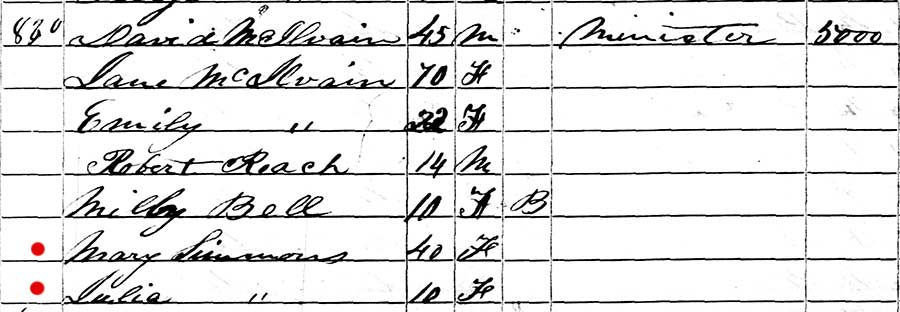
It's not known why Julia's sister wasn't listed, she would have been
around 9 to 11 in 1850.
Jeane McIlvaine married
Robert H. Beville in
Florida in 1866 and when
she was widowed, she
lived with Julia and
William Haisley, along
with her two children
Alfred Stephen Beville
and Mary Helen Beville.
In Julia's later years
after William died,
Julia spent a lot of
time with her sister and
niece Helen, who lived
in nearby Gainesville.
|
|
JULIA
SIMMONS'S
FIRST
MARRIAGE -
ALFRED C.
BROWN
Julia's
first
marriage was
one
apparently
unknown of
or forgotten
in her later
years. The
surname of
her widowing
from her
next
marriage,
"Priest"
would be the
one that
stayed with
her to the
end of her
life. |
|
On Oct. 19,
1861, Julia
M. Simmons
and Alfred
C. Brown
obtained a
license to
marry from
the clerk of
the court in
Marion
County
(Ocala.)
They were
married
three days
later at
Cedar Key,
Levy County,
on Oct. 22,
1861, by
Minister of
the Gospel
Wm. T.
Harrison.
Julia would
have been 21
to 23 years
old at the
time.
 A.
C. Brown was
on the 1850
Census of
Ocala,
Marion Co,
living in
the
"Broadway
House" with
some
seemingly
unrelated
boarders. A.
C. Brown was
26, born in
Georgia, and
his
occupation
was listed
as "M.D."--medical
doctor. A.
C. Brown was
on the 1850
Census of
Ocala,
Marion Co,
living in
the
"Broadway
House" with
some
seemingly
unrelated
boarders. A.
C. Brown was
26, born in
Georgia, and
his
occupation
was listed
as "M.D."--medical
doctor.
He appears
to be this
same
Alfred C.
Brown who
died in 1865
and is
buried in
Evergreen
Cemetery,
Ocala.
He would
have been
around 37 to
38 when he
married
Julia in
1861.
Photo
from
Find-A-Grave.
by
Teresa. |
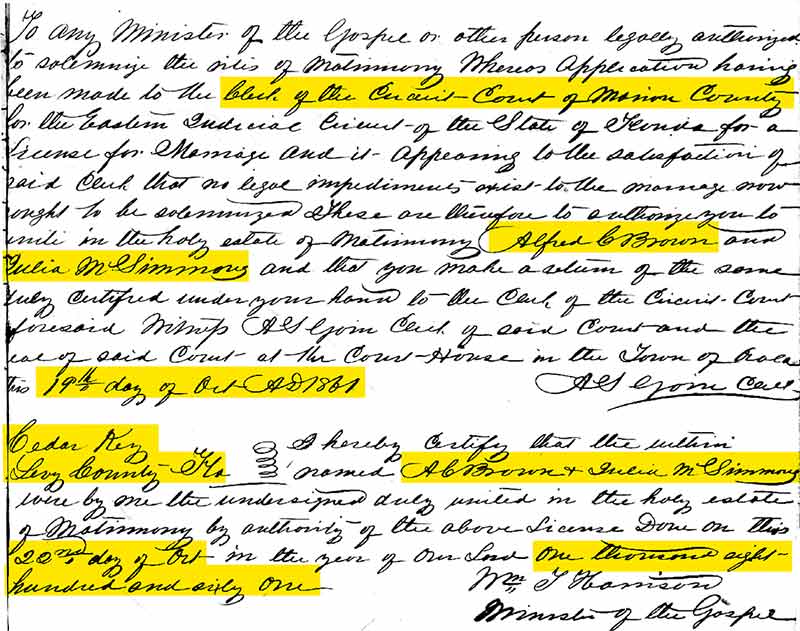
Marriage
License &
Cert. of
Julia M.
Simmons &
Alfred C.
Brown.
Oct. 19,
1861, Marion
County &
Oct. 22,
1861 Levy
County
Click the
image to see
it larger. |
|
JULIA
SIMMONS'S
SECOND
MARRIAGE -
BENJAMIN
FRANKLIN
PRIEST
On Dec. 15,
1870, Julia
married
Benjamin
Franklin
Priest at
the Marion
County
courthouse
in Ocala.
The ceremony
was
performed by
S. T.
Phillipps,
Clergyman of
the P.E.
Church
Diocese of
Fla.
Julia would
have been
around 31 or
32 years old
at the time.
On the June
1, 1870
Census of
Florida,
Benjamin
Priest is
listed as a
farmer, 38
years old,
born in
Florida.
There are
apparently
no relatives
living with
him, only a
farm hand
and his wife
and children
appear with
him
|
 He was probably the Benjamin Priest on the 1850 census, age 18, whose parents were Gabriel Priest Sr. (of Mass.) and Ann M. (of Ga.) He was probably the Benjamin Priest on the 1850 census, age 18, whose parents were Gabriel Priest Sr. (of Mass.) and Ann M. (of Ga.)
Benjamin
Franklin
Priest, b.
1832, died
Jan 24, 1875
and is
buried in
Evergreen
Cemetery,
Ocala.
From
Find-A-Grave:
Benjamin F.
Priest, a
Marion
County
native who
had served
as a captain
in the Civil
War, was
elected
Sheriff
after the
war, serving
until 1868.
Photo by
Teresa. |

Click the image to see it larger. |
|
|
WILLIAM P. HAISLEY'S
REPORT COVERING HIS
FIRST TWO YEARS OF
HIS SUPERINTENDENCE
After getting his
office in order,
William spent the
first part of his
term traveling the
state and getting a
first hand look at
the conditions of
public schools, as
well as meeting with
county school
superintendents and
the citizens of the
area.
 |
|
REPORT -
DEC. 31,
1878 |
MAIN POINTS |
|
The friends
of education
and those
who desire
the success
of our
common
school
system, can
but feel
gratified at
the progress
that has
been made
daring the
past two
years.
The
statistical
tables below
given, show
that
nearly one
thousand
schools have
been
organized up
to this time
in our
State, an
increase of
several
hundred in
the period
referred to,
the highest
number ever
before
reported
being
something
less than
six hundred.
The
improvement
in this
particular
may be
easily seen
and is most
encouraging,
but it is
not the only
feature
which has
marked a
forward
movement.
A longer
school term
has been
given, a
larger
percentage
of the
school
population
has been
enrolled,
and better
qualified
and more
efficient
teachers
have been
employed.
Besides
this the
financial
condition of
many of the
counties has
been very
greatly
improved.
At the
beginning of
the time
embraced in
my report, a
number of
the county
Boards were
sadly
embarrassed
with debts
which had
accumulated
from year to
year,
and which as
a matter of
course
exercised a
depreciating
influence
upon
warrants.
By judicious
and
economical
management,
however,
these
obligations
have now
nearly all
been
cancelled,
and in
hardly any
county at
this time is
school scrip
to be had at
less than
par.
These facts
not only
speak well
for the
officers who
have been
connected
with the
Department,
but they
also exhibit
an
appreciation
of education
on the part
of the
people which
is quite as
desirable,
and without
which it
would be
impossible
to
accomplish
but little.
I believe
that all
classes
throughout
the State
are now more
fully alive
to the
importance
of
maintaining
the common
school
system than
ever before
at any
period since
its
inauguration,
and that we
may hope for
still higher
and better
results in
the future.
REORGANIZATION
OF THE
BOARDS.
It was
early
determined
by the
present
Board of
Education to
reduce the
Boards of
Public
Instruction,
except in a
few of the
most
populous
counties,
from five to
three
members each.
This plan
has been
found to
work well,
and besides
has been
a saving to
the State of
nearly
fifteen
hundred
dollars per
annum
from the
time of its
adoption. In
addition to
this
a thorough
reorganization
of every
county was
made, and
each School
Board
required to
place on
file with
the head of
the
Department
the
certificate
of
organization
required by
law some-
thing which
had never
been done
before,
or if so
there was no
evidence to
that effect
among the
records of
the office.
OFFICIAL
CANVASS OF
THE STATE BY
THE
SUPERINTENDENT
Believing
that an
official
visit to
each of the
counties in
the State
would enable
the
Superintendent
to perform
more
intelligently
the duties
of his
position,
and be of
benefit in
other
respects to
the success
of the
public
schools,
the
Board of
Education
decided to
apply tie
five hundred
dollars per
annum which
had hitherto
been
appropriated
as a
contingent
fund to this
office, in
defraying
the
traveling
and other
expenses
which a tour
of the State
would
involve.
After a
thorough
reorganization
of the
department
therefore, I
entered upon
this
canvass,
starting out
first in
July, 1877.
My plan was
to take in a
certain
section of
the State or
a certain
number of
counties in
each visit.
Remaining
out one or
two months
at a time, I
would return
to the
office, and
after
working up
such
business as
required my
personal
attention,
would again
resume my
visits, thus
continuing
until
September,
1878, when
every county
had been
visited.
This work
consumed
between five
and six
months of
actual
travel, and,
as any one
who has ever
made a
thorough
canvass of
the State is
aware, was
attended
with many
difficulties
and much
inconvenience.
I feel
assured
however that
my visits
have
resulted in
benefit to
the cause in
which I am
engaged, and
do not
therefore
regret the
many
hardships
which from
the nature
of the task,
I was forced
to endure.
In these
visits the
Superintendent
met each
Board of
Public
Instruction
in the
State, and
endeavored
to inform
them as to a
proper
construction
of the law
and their
duties under
the same. In
this way he
has become
personally
acquainted
with every
school
officer,
thus
strengthening
the bond of
those
engaged in a
common work,
and
awakening an
interest,
and in some
cases an
enthusiasm
which could
have been
effected by
no other
means. He
has also met
and
conversed
with many
bearing no
official
relation to
the common
schools,
from whom he
has gained
information
as to the
interests,
inclinations
and wants of
the people,
which could
not
otherwise
have been
obtained,
and which
has been of
great
benefit to
him in the
proper
discharge of
his duties.
He feels
justified in
saying
therefore
that many
and good
results have
followed
from this
official
canvass.
SCHOOL
POPULATION.
Below will
be found a
statement of
the school
census for
1876, which
has never
before been
published.
On comparing
the returns
here given
with those
of 1873, it
will be seen
that there
was an
increase in
our school
population
between the
years 1873
and 1876 of
nearly
thirteen
thousand,
the total
number
reported in
the previous
census
between the
ages of 4
and 21 being
only 74,828.
From two
counties
there are no
returns ;
from two
they are
inaccurate,
from one
deficient. |
Gratifying
progress was
made in the
past 2
years. There
were almost
1,000
organized
schools in
the state,
an increase
of several
hundred.
The highest
increase to
date had
been 600.
A longer
school term
had been
established,
a larger
percentage
of school
age
population
had been
enrolled,
better
qualified
teachers
employed,
the
financial
condition of
many
counties
were greatly
improved. At
the
beginning of
his term, a
number of
county
boards were
embarrassingly
in debt, but
due to
management,
obligations
have been
eliminated.
All classes
of
Floridians
are become
more aware
of the
importance
of an
education
and
maintaining
a common
school
system.
Except in
the most
populated
counties,
the number
of county
school board
members was
reduced by
the state
board from
five to
three
members,
saving the
state $1,500
a year.
Every county
school board
was
reorganized
and required
to file
their
certificate
of
organization
with the
state, which
had never
been done
before.
The state
board
allowed
Haisley to
make an
official
visit to
every county
of the state
and meet
with each
county
board, so he
could do a
better job
as State
Supt.
After a
complete
reorganization
of the
department,
he started
his tour of
the state in
July 1877,
by visiting
the counties
in
geographic
groups,
spending one
or two
months in
each
section,
then
returning to
his office
to catch up
on state
business.
This
itinerary
took him
until Sept.
1878 to
visit all
counties,
taking up
between five
and six
months of
travel time,
accompanied
by many
difficulties
and
inconveniences.
He did not
regret the
many
hardships
the task
forced him
to endure,
believing it
was to the
benefit of
his cause.
He met with
the Supt. of
each board
of public
instruction
in each
county,
reviewing
with them
the law and
their duties
under it.
In meeting
with them
personally,
he formed
bonds with
them due to
their common
work, and
generated an
enthusiasm
for it which
no other way
would have
been
generated.
He also met
with
numerous
persons not
officially
part of the
government
educational
system, and
gained much
knowledge of
what
interests
and wants
the people
had, which
was a great
benefit to
him in doing
his job.
Many good
results have
followed due
to his tour
of the
state.
A chart of
the school
census for
1876 was
published,
showing an
increase of
nearly
13,000
children
over the
previous
school age
population
of about
75,000.
You can read
all of this
report with
charts and
stats at
Internet
Archive.
You might
need to sign
up, but it
is free.
This site is
a priceless
resource.
It allows
you to flip
through
pages online
or download
several
different
versions of
books from
PDF to plain
text. |

The INDIANAPOLIS NEWS
took opportunity on May
28, 1879 to boast about
their native son with
this article stating how
well William was doing
in using the state tax
for education in
Florida; "The school
fund is most carefully
guarded by the
superintendent of public
instruction, William P.
Haisley, a former
resident of Indiana.
1880 Census, Marion
County (location of
Ocala), Fla.
William
P. Haisley, Supt. of
Public Instruction

The Haisleys
were living Marion Co,
Fla. and William was
nearing the end of his
term as
State Superintendent of
Public Instruction.
In his home was his
wife, Julia S., her
widowed mother, Mary
(McIlvaine) Simmons, William's
widowed sister Jeany H.
Beville, her two
children, a waiter, his
wife and his widowed
mother. Julia's
mother may have provided
the info for this census
because W.P.'s age is
about 9 years too young
and his birth place of
Illinois is also
incorrect, he was born
in Indiana.
WILLIAM P. HAISLEY'S
SPEECH IN TALLAHASSEE
On Mar. 3, 1880, William
made a speech at the
courthouse in
Tallahassee.
He opened by stating
that Florida was at
about the 54th
percentile of illiteracy
compared to other states
for both races, but only
at about 18th percentile
for the white
population. [As these
are illiteracy rates, a
lower percentile is
better.] He said
Florida's public school
system was the "cheapest
and best" and worth
supporting by the
people. As the right of
the state to impose an
education tax was
questioned by many
Floridians, Haisley
pointed out that this
right was backed by the
opinions of Chief
Justice Marshall and
Thomas Jefferson.
Florida's defect was
that
it had a tendency to
centralize or go to the
other extreme--disperse
too widely, and Haisley
had the opinion that
having each county be
one school district was
the only way currently
possible to organize.
Haisley appeared to be
opposed to using the
school funds for
anything other than the
"common school
branches," which implies
he was not in favor of
funding higher
educational
institutions.
Haisley was in favor of
raising the state school
tax, but he saw the only
way to collect it was in
the form of a statute
requiring voters to
present a paid receipt
from the tax collector
at the polls when they
came to vote.
Haisley also felt that
the state Seminary and
Agricultural funds could
be better used because
they weren't fulfilling
their purposes, citing
that agricultural
colleges had failed in
older states where they
had been established.
Out of some 38
Agricultural colleges in
the country, on three
could be considered
successful, and those
required heavy funding
from the state.
Haisley was in favor of
combining the
institutions into a
first-class Normal
School, and judging by
the success of the
Peabody Normal School in
Nashville, he had no
doubt this could be
established in Florida
and door more good than
the present Seminaries
and the proposed
Agricultural College.
Haisley compared
Florida's funding of the
school system to that of
New York and said that
Florida's rate was
higher in proportion to
the states individual
wealth. He urged
the importance of
teachers' institutes to
promote the educational
interests of Florida
until something better
could be provided.
The Tribune closed by
commenting that they
thought this was a fair
assessment of Haisley's
speech and they believed
that he had been
unfairly criticized in
matters of which he was
no more accountable for
than the people of
Florida. It said
that the last
Legislature limited the
school tax to 2.5 mils
because they felt it was
sufficient even during
Republican rule, and
that a new method of
collecting the taxes
would have insured a
considerable increase of
taxable property in the
state. (Haisley's
next Biennial Report
would indicate that it
was a mistake they then
realized.)
-Haisely-speech-as-state-spt.jpg)

This article refers to a
speech William made on
May 24, 1880 at Wilson's
Hall in Quincy, FL.
It refers to some of the
same topics covered by
William in Tallahassee
in March. He
"received the absorbed
attention of his hearers
throughout its delivery"
William proved the
necessity of education
with his argument and
statistics, the right to
tax as being confirmed
by Chief Justice
Marshall, and that the
public school system of
Florida was the cheapest
and best method, along
with ways to improve the
efficiency of public
schools.
"Mr. Haisley is a fine
speaker and made a
strong argument not easy
of refutation."
-Education-in-South-Fla-compared-to-Philly.jpg)
FLORIDA'S PRIORITY ON
EDUCATION SETTING AN
EXAMPLE IN THE NORTH
This Feb. 12, 1881
article in the Jackson
(Miss.) COMET refers to
an article published in
the Philadelphia Times.
Even in big northern
cities where education
was considered to be of
higher quality,
Haisley's performance
was being was being
recognized, as well as
Florida's priority on
education.
It points out that
Florida had a taxable
property value not even
one-fiftieth of the city
of Philadelphia, a
greater proportion was
being used for educating
blacks and whites than
was being spent in the
North.
WILLIAM P. HAISLEY'S
SECOND AND FINAL
BIENNIAL REPORT
William speaks of a
recent reduction of the
state's county school
tax being a mistake, and
when everyone realized
it, they were encouraged
that the original rate
would be restored at the
next meeting of the
State Legislature.
He continues with the
importance of
sufficiently funding the
state's schools.
|
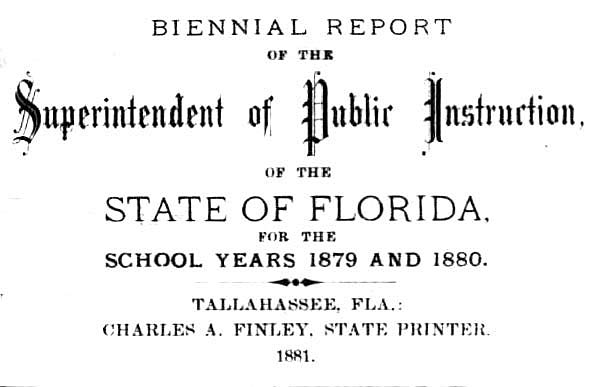
In
reviewing
the
condition of
the public
schools of
our State
during the
past two
years it is
gratifying
to note,
that
notwithstanding
the
difficulties
under which
they have
been
operated,
there has
been a
decided
improvement.
While the
period
referred to
has been
fruitful in
the actual
good
accomplished,
there has
been
something
still more
encouraging
in its
indications
of future
success. The
fact that a
greater
number of
schools have
been
operated,
with a
diminished
revenue,
shows that
there is an
increased
public
sentiment in
their favor,
and that a
majority of
the people
of our State
begin to
feel the
necessity of
developing
our
educational
system.
I would not,
however, be
understood
here as
adducing an
argument in
defense of
the action
of the last
General
Assembly in
reducing the
county tax
for the
support of
schools. Had
it been
thought that
the limited
percentage
of taxation
was to
remain
permanent,
the result
would have
been
different,
but under
the general
sentiment
that the
reduction
was a
mistake, and
that the
original
rate would
be restored
when the
next
Legislature
should meet,
the people
have been
encouraged
in keeping
up their
school
organizations,
and have
supplemented
in many
instances by
private
contributions
the
appropriation
allowed.
If It is
important
that we
should have
a public
school
system, and
every
thinking
mind must
admit that
it is, then
policy
demands that
it be
operated in
such manner
as will make
it of most
advantage to
the State.
This can
only be done
by giving to
it a
sufficiency
of funds,
without
which we
shall fail,
not only to
develop the
system, but
the public
school will
result in
detriment to
true
educational
advancement.
There are
neighborhoods
that will
depend for
the support
of their
school upon
the public
fund,
however
insufficient
for the
purpose it
may be. So
the school
is put in
operation
once a year,
they are
satisfied,
without
giving
themselves
any concern
as to
whether it
is conducted
by such a
teacher, or
for such a
length of
term as will
make it of
real value
to the
children.
Thus evil
instead of
good is the
result if
the system
is not
liberally
supported.
He then goes
on to
describe his
experiences
and findings
of his
second
canvass of
the entire
state.
You can read
the entire
report here
at Internet
Archive.
You may need
to register,
but it is
free and
well worth
the few
minutes. |
| |
WILLIAM'S RETIREMENT
YEARS
In his
retirement
years,
William made
frequent visits to Tampa
from Ocala to check in
on friends and see how
his orange grove and his
various properties were
doing.
1885 Census, Marion
Co., Ocala, Fla.
W. P.
Haisley with wife and
mother-in-law

William was now 53 and a "Gr.
Owner" (Grove owner,
probably oranges.)
Julia S. was 46, her
mother M. (Mary) M.
Simmons was 75.
Places of birth were
Ind., Pen., Del.
William owned a grove in the
area of Hillsborough
County referred to as
his "Philippe grove."
This was in the area of
Safety Harbor now, where
early Hillsborough
County pioneer Odet
Philippe had settled in the
mid 1800s. His
land is a county park
which now bears his
name.
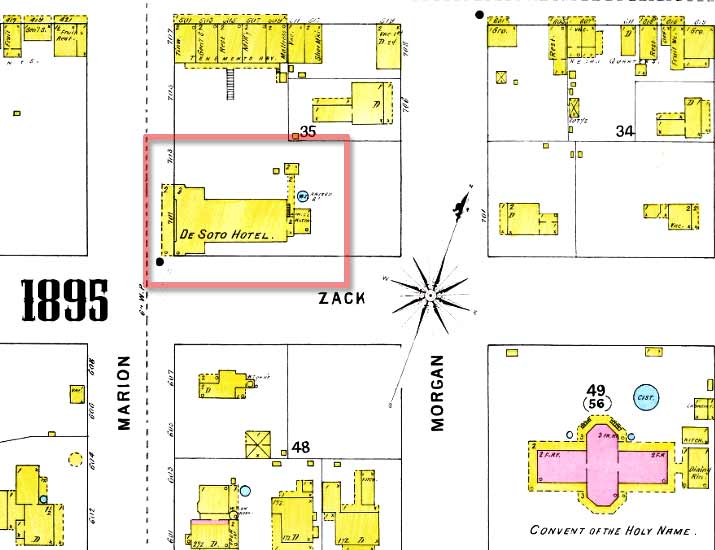
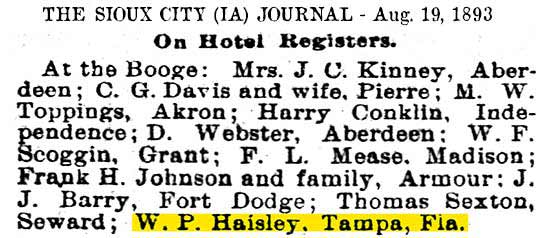
William checked into the
Booge Hotel in Sioux
City, Iowa, on Aug 19,
1893.
When visiting in Tampa,
William would often stay
at the DeSoto Hotel,
which was located at
Marion and Zack Streets.
Articles in the local
papers say the manager
there was his nephew, W.
D. Lewis.

How were they related?
WHO
WAS W. D.
LEWIS?
|
|
W. D.
Lewis lived
in Tampa for
about eight
years from
1890 to
1897.
In that
time he
became
well-known
for his
"basso profundo"
singing
voice and
the most
entertaining
manager of
the DeSoto
Hotel.
Afterward,
he moved to
Louisville,
KY for a
short time
and then to
Dayton, Ohio
where he became
one of the
leading
vocal musicians
and
professors
of music in the first
decade of
the 20th
Century.
READ ABOUT
W. D. LEWIS
and the
history of
the DESOTO
HOTEL, here
on this
breakout
page.
Don't miss
it, there's
a lot of
good Tampa
history
here, as
well as
beautiful
photos of
the DeSoto,
outside and
inside.
1921 -
Company B of
the
Hillsborough
Co. Home
Guards lined
up in front
of the
DeSoto Hotel
Burgert
Brothers
Cirkut
Camera
Panoramic
image from
the
collection
of the Tampa
Hillsborough
Co. Public
Library
website.
These
negatives
are named
after the
special
Cirkut
camera that
could rotate
up to 360°
to produce
sweeping
panoramic
views.
The
negatives
were
produced on
nitrate film
and had
deteriorated
severely
over the
years. The
library has
created new
negatives
and prints
from these
old
negatives.
Read about
the Cirkut
Camera at
the TampaPix
Burgert
Bros.
feature. |
THIS FEATURE IS
UNFINISHED - MORE
COMING LATER
|
Feb. 24,
1890 -
William
returned
home to
Ocala after
his annual
visit to
Tampa to
check on his
grove.
He gave the
Ocala Banner
a fine
review of
Tampa
calling it
"the future
great Gulf
coast city
of Tampa."
He also
attended
boat races
at Port
Tampa, which
drew a crowd
of 5,000
spectators. |
. |
This article
is the basis
of knowing
where his
school was
located and
the latest
he would
have been
living in
Tampa--1872. |
|
 |
|
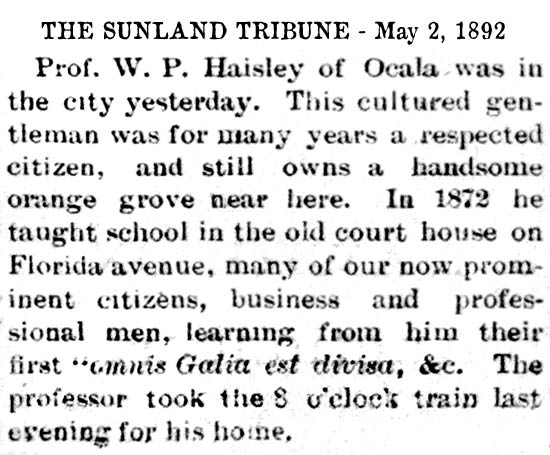 |
|
1894-09-21
Wallace
Stovall
editor of
Tpa Trib,
pointed out
10-acre
property in
Tampa
Heights for
which
Haisley
refused $40k
offer for.
He paid
$2000 wants
$100,000 for
it.
1894-08-17
Haisley of
Ocala in
Tampa, uncle
of fine host
of the DeSoto
Hotel, W.D
Lewis.
|
(From Julius
Caesar's
Commentaries
on the
Gallic War.
The work has
been a
mainstay in
the teaching
of Latin to
schoolchildren,
its simple,
direct prose
lending
itself to
that
purpose. It
begins with
the
frequently
quoted
phrase "Gallia
est omnis
divisa in
partes tres",
sometimes
quoted as "Omnia
Gallia in
tres partes
divisa est",
meaning "All
Gaul is
divided into
three
parts.") |
 |
March 9,
1895
|
|
1895-05-09
TRIB
Haisleys
of Ocala
in Tampa
1895-07-12
TRIB
Haisley
visiting
Tampa,
still
considers
home
1895-12-07
TRIB
Haisley
at the
Plant,
owns
property
in Tpa
Hts
1896-06-08
OCALA
EVE STAR
L J
Haisley
leaving
Ocala
for
north
big
deals
1896-11-13
OCALA
EVE STAR
Haisley
to Tampa
location
of grove
1896-11-19
WEEKLY
TRIB -
Haisley
visits
grove,
location
described
1897-07-01
WEEKLY
TRIB
Haisley
returns
home
from
Tampa
1897-09-24
OCALA
BANNER
Haisley
back
from
Tampa
1897-10-04
OCALA
EVE STAR
Julia
Haisley
missionary
box
1898-09-28
Haisley
grove
location,
calling
on
friends
in Tampa
1898-10-01
OCALA
EVE STAR
Haisley
inspecting
groves
today
1898-10-07
OCALA
EVE STAR
Haisley
grove
expectations
1898-11-10
WEEKLY
TRIB
Haisley
votes in
Tampa,
lives in
Ocala
1899-09-06
OCALA
EVE STAR
Haisley
in war
paint
1899-12-10
TRIB
Haisley
visiting
Tampa
1899-12-23
OCALA
EVE STAR
Haisley
returns
from
Tampa
after
overseeing
shipments
|
 |
 |
|
1900 Census, Marion Co,
Fla.
W. P. Haisley
 |

